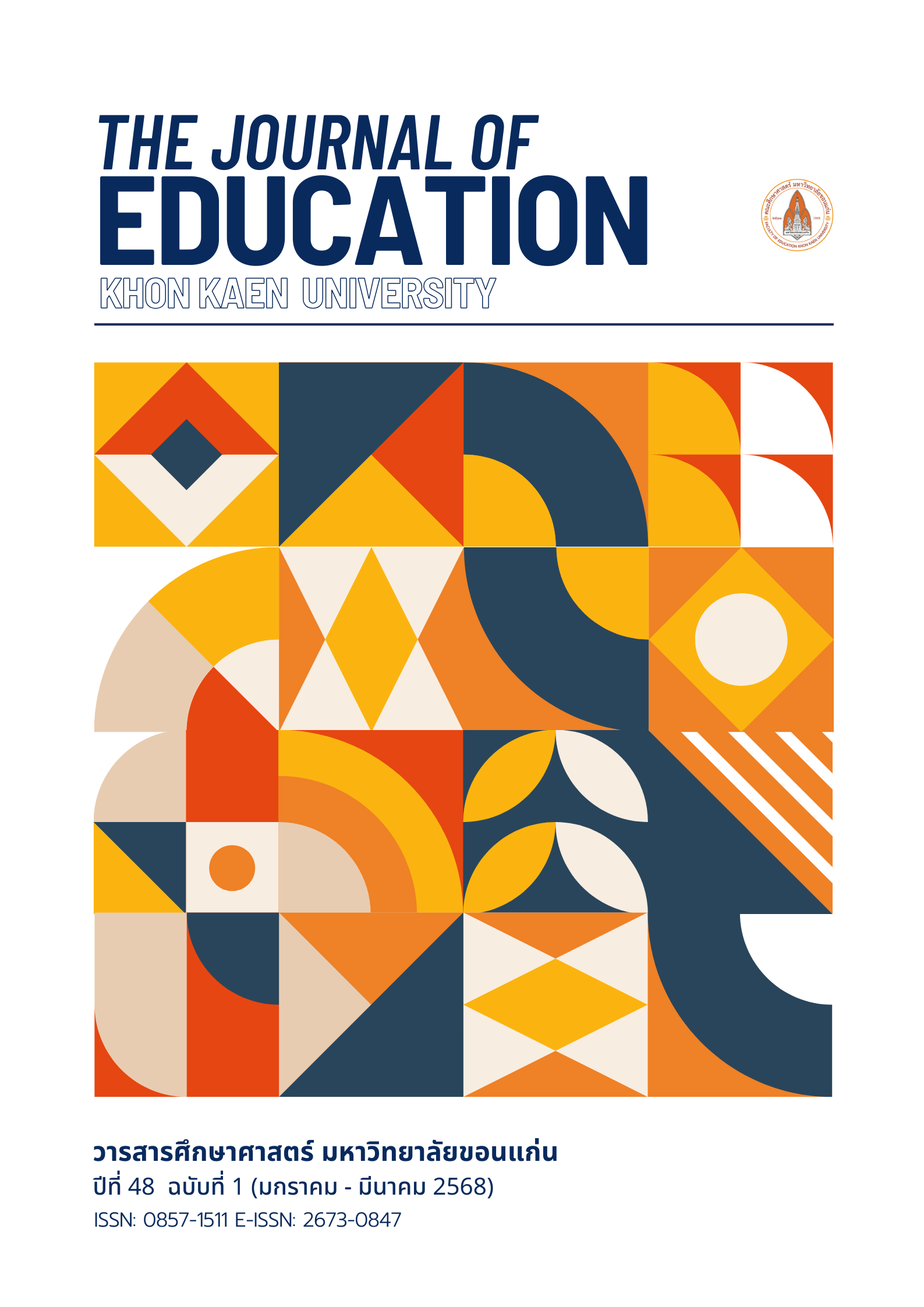การพัฒนาความสามารถในการอ่านภาษาอังกฤษเพื่อความเข้าใจโดยใช้วิธีการจัดการเรียนรู้ด้วยเทคนิค CIRC ร่วมกับแอปพลิเคชัน สำหรับนักเรียนชั้นประถมศึกษาปีที่ 5
Main Article Content
บทคัดย่อ
บทความวิจัยนี้นำเสนอการพัฒนาความสามารถในการอ่านภาษาอังกฤษเพื่อความเข้าใจโดยใช้วิธีการจัดการเรียนรู้แบบ CIRC ร่วมกับแอปพลิเคชัน สำหรับนักเรียนชั้นประถมศึกษาปีที่ 5 โดยมีวัตถุประสงค์ 1) เพื่อเปรียบเทียบความสามารถในการอ่านภาษาอังกฤษเพื่อความเข้าใจก่อนและหลังเรียนโดยใช้วิธีการจัดการเรียนรู้แบบ CIRC ร่วมกับแอปพลิเคชัน 2) เพื่อศึกษาความพึงพอใจที่มีต่อการจัดการเรียนรู้โดยใช้วิธีการจัดการเรียนรู้แบบ CIRC ร่วมกับแอปพลิเคชัน กลุ่มเป้าหมายคือ นักเรียนชั้นประถมศึกษาปีที่ 5 นักเรียนระดับชั้นประถมศึกษาปีที่ 5 โรงเรียนขนาดกลาง สังกัดสำนักงานเขตพื้นที่การศึกษาประถมศึกษาเพชรบูรณ์ เขต 2 จังหวัดเพชรบูรณ์ จำนวน 16 คน ได้มาโดยการเลือกแบบเจาะจง (Purposive Sampling) เครื่องมือที่ใช้ในการวิจัยมีดังนี้ 1) แผนการจัดการเรียนรู้เพื่อพัฒนาความสามารถการอ่านเพื่อความเข้าใจโดยใช้เทคนิค CIRC ร่วมกับแอปพลิเคชัน สำหรับนักเรียนชั้นประถมศึกษาปีที่ 5 จำนวน 6 เรื่อง 2) แบบประเมินความพึงพอใจของนักเรียนระดับชั้นประถมศึกษาปีที่ 5 ที่มีต่อการจัดการเรียนรู้โดยใช้เทคนิค CIRC ร่วมกับแอปพลิเคชัน
ผลการวิจัยพบว่า
- คะแนนความสามารถในการอ่านภาษาอังกฤษเพื่อความเข้าใจของนักเรียนหลังเรียนโดยใช้เทคนิค CIRC ร่วมกับแอปพลิเคชัน สำหรับนักเรียนชั้นประถมศึกษาปีที่ 5 สูงขึ้นกว่าก่อนเรียน
- ระดับความพึงพอใจที่มีต่อการจัดการเรียนรู้โดยใช้เทคนิค CIRC ร่วมกับแอปพลิเคชันสำหรับนักเรียนชั้นประถมศึกษาปีที่ 5 ภาพรวมทั้ง 3 ด้าน อยู่ในระดับมากที่สุด ที่ค่าเฉลี่ย 4.54
Article Details

อนุญาตภายใต้เงื่อนไข Creative Commons Attribution-NonCommercial-NoDerivatives 4.0 International License.
เอกสารอ้างอิง
กระทรวงศึกษาธิการ. (2551). หลักสูตรแกนกลางการศึกษาขั้นพื้นฐาน พุทธศักราช 2551. สำนักวิชาการและมาตรฐานการศึกษา.
จันทรพิมพ์ รังษี.(2565). การพัฒนาการอ่านภาษาอังกฤษเพื่อความเข้าใจ โดยการใช้เทคนิค SQ6R ของนักเรียนชั้นมัธยมศึกษาปีที่ 4 โรงเรียนรัตนราษฎร์บำรุง.การค้นคว้าอิสระปริญญาหลักสูตรศึกษาศาสตรมหาบัณฑิต มหาวิทยาลัยศิลปากร.
ทิศนา แขมณี. (2552). ศิลปะการสอน: รูปแบบการจัดการเรียนรู้ที่มีประสิทธิภาพ. สำนักพิมพ์แห่งจุฬาลงกรณ์มหาวิทยาลัย.
ธิดา ทิพย์สุข. (2552). การพัฒนาผลการเรียนรู้ด้านการอ่านและการเขียนภาษาอังกฤษเพื่อการ สื่อสารของนักเรียนชั้นมัธยมศึกษาปีที่ 3 ที่จัดการเรียนรู้ด้วยเทคนิค CIRC. (วิทยานิพนธ์ศึกษาศาสตรมหาบัณฑิต). มหาวิทยาลัยศิลปากร.
นัฐตราภรณ์ สิทธิ. (2565). การพัฒนาทักษะการอ่านออกเสียงภาษาอังกฤษ โดยใช้แอปพลิเคชันร่วมกับเทคนิค CIRC ของนักเรียนชั้นมัธยมศึกษาปี ที่ 1 โรงเรียนขยายโอกาสแห่งหนึ่งในจังหวัดปทุมธานี (วิทยานิพนธ์ศึกษาศาสตรมหาบัณฑิต, มหาวิทยาลัยรังษิต). https://rsuir-library.rsu.ac.th/bitstream/123456789/2148/1/NATTRAPORN%20SITTI.pdf
นัฐตราภรณ์ สิทธิและชิดชไม วิสุตกุล. (2565). การพัฒนาการอ่านออกเสียงภาษาอังกฤษโดยใช้แอปพลิเคชันร่วมกับเทคนิค CIRC ของนักเรียนชั้นมัธยมศึกษาปีที่ 1 โรงเรียนขยายโอกาสแห่งหนึ่งในจังหวัดปทุมธานี. วารสารครุศาสตร์ปริทรรศน์ฯ. 9 (3), 255-267.
พัทธ์ธนันต์ แสงพลอย. (2565). ผลของการสอนแบบบูรณาการเนื้อหาและภาษา(CLIL) เพื่อส่งเสริมทักษะการอ่านภาษาอังกฤษเพื่อความเข้าใจ ของนักเรียนระดับชั้นประถมศึกษาปีที่ 5. การค้นคว้าอิสระศึกษาศาสตรมหาบัณฑิต, สาขาวิชาการสอนภาษาอังกฤษ, มหาวิทยาลัยศิลปากร
ลาวัณย์ สังขพันธานนท์ และคณะ (2549). การอ่านเพื่อพัฒนาคุณภาพชีวิต. กรุงเทพฯ : มหาวิทยาลัยมหาสารคาม.
วัชรา เล่าเรียนดี. เทคนิคการจัดการเรียนร้สำหรับครูมืออาชีพ. นครปฐม : คณะศึกษาศาสตร์ มหาวิทยาลัยศิลปากร, 2547.
สมุทร เซ็นเชาวนิช (2545). เทคนิคการอ่านภาษาอังกฤษเพื่อความเข้าใจ. พิมพ์ครั้งที่ 11. กรุงเทพ: มหาวิทยาลัยธรรมศาสตร์.
สุมิตราอังวัฒนกุล. (2540). วิธีสอนภาษาอังกฤษ. กรุงเทพฯ : จุฬาลงกรณ์มหาวิทยาลัย.
อรณัน เผื่อนผึ่ง. (2555). การพัฒนาหลักสูตรอบรมการใช้คอมพิวเตอร์ แท็บเล็ตเพื่อการเรียนรู้เรื่องการทำภาพ
สติ๊กเกอร์ด้วย iPad2 (Unpublished Master’s thesis). มหาวิทยาลัยราชภัฏมหาสารคาม, มหาสารคาม
อัจฉรา วงศ์โสธร. (2544). การทดสอบและประเมินผลการเรียนการสอนภาษาอังกฤษ. พิมพ์ครั้งที่ 2. กรุงเทพมหานคร:
สำนักพิมพ์จุฬาลงกรณ์.
อุบลรัตน์ ศุริสุขโภคา และสรเดช ครุฑจ้อน. (2562). การพัฒนาโมบายแอปพลิเคชันเพื่อเสริมทักษะการอ่าน ออกเสียงภาษาอังกฤษ สําหรับนักเรียนชั้นประถมศึกษาปีที่ 3 ที่เรียนด้วยเทคนิคการเรียนแบบห้องเรียนกลับด้าน. วารสารวิชาการครุศาสตร์อุตสาหกรรม พระจอมเกล้าพระนครเหนือ. 10(2).227-236.
ไอลดา จันทร์ลอย. (2562). การอ่านออกเสียงคำศัพท์ภาษาอังกฤษโดยการเรียนรู้แบบเพื่อนช่วยเพื่อนของ
นักเรียนชั้นประถมศึกษาปีที่ 4. วิทยานิพนธ์ศึกษาศาสตรมหาบัณฑิต. มหาวิทยาลัยธุรกิจบัณฑิตย์.
Ali, J.K.M., & Bin-Hady, W. R. A. (2019). A Study of EFL Students’ Attitudes, Motivation and Anxiety towards WhatsApp as a Language Learning Tool. Arab World English Journal (AWEJ). Special Issue on CALL (5). 289-298
Bekešová, J., & Romanová, I. (2019). Six technological innovations that changed English language
teaching. ICTE Journal, 8(1), 30-38. https://doi.org/10.2478/ijicte-2019-0003
Clarke, B., & Svanaes, S. (2015). Updated review of the global use of mobile technology in education. Techknowledge for Schools. Retrieved from
https://www.kidsandyouth.com/pdf/T4S%20FK%26Y%20Literature%20Review%2011.12.15.pdf Heaton, J. B. (1990). Classroom Testing (2nd ed.). New York: Longman.
Jaroslav K., & Blanka K. (2019). Use of Smartphone Applications in English Language Learning-A Challenge
for Foreign Language Education. Master’s thesis. Czech Republic, University of Hradec Králové.
Johnson, D. W., & Johnson, R.T. (1987). Learning Together and Alone: Cooperative, Competitive and
Individualistic Learning. 2nd ed. New Jersey: Prentice-Hall.
König, L. (2021). Podcasts in higher education: teacher enthusiasm increases students’ excitement, interest,
enjoyment, and learning motivation. Educational Studies, 47(5), 627-630.
https://doi.org/10.1080/03055698.2019.1706040
Nouri, J., & Pargman, T. C. (2016, September). When teaching practices meet tablets’ affordances. Insights
on the materiality of learning. In European Conference on Technology Enhanced Learning (pp. 179-192). Springer, Cham. https://doi.org/10.1007/978-3-319-45153-4_14
Rohdearni Wati Sipayung. (2019). Improving the Students’ Ability in Reading Comprehension by Using
Cooperative Integrated Reading Composition. Budapest International
Research and Critics Institute-Journal (BIRCI-Journal). 2(2) : 247-253
Slavin, Robert E. (1995). Cooperative Integrated Reading and Composition (CIRC): A Brief Overview. 2nd ed.
Massachusetts: A Simon & Schuster.
Stevens, R.J., Madden, N.A., Slavin, R.E., & Farnish, A.M. (1987). Cooperative integrated reading and
composition: Two field experiments. Reading Research Quarterly, 22(4), 433-454.
Zheng, Q., Chen, T., & Kong, D. (2017). An empirical study on context awareness integrated mobile assisted
instruction and the factors. Eurasia Journal of Mathematics, Science and Technology Education,
(6), 1737-1747. https://doi.org/10.12973/eurasia.2017.00695a


